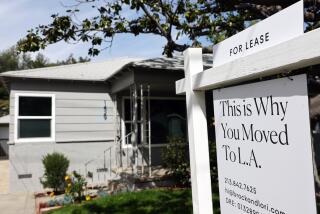Most U. S. Elderly Appear Well-Housed
- Share via
Housing designed for the elderly constitutes a complex, diversified challenge to U.S. builders and developers--mainly because most older persons are already well-housed and know it.
That was one of the areas of agreement among several speakers at the first-ever seminar on housing for the elderly held here recently by the Mortgage Bankers Assn. of America.
Bruce Jacobs, whose specialties are housing and public policy analysis at the University of Rochester, N.Y., declared that his research shows that most older person “like where they live” and most have no plans to move.
He added that most seniors also are “as well off as the rest of the population” and maybe a bit more so because of special benefits attendant with old age (pensions, tax breaks and federal support for medical care).
Although he did not denigrate reasons why older persons might want to leave their usually paid-for homesteads, Jacobs did point out that a Lou Harris survey of older Americans showed housing to be one of the lowest-rated concerns of that upper-age group. “They were shown to be much more concerned about crime and health,” Jacobs said.
In introducing the symposium on housing for the elderly as an initiative of the MBA, President Thomas M. French Jr. (a white-haired Texan in his early 60s), stressed statistics showing how America’s older population will double in the next 40 years.
He also said that 65% of older persons own their houses outright and want to stay there as long as possible. But he also cited the difficulty of that independent form of living for older, single spouses--pointing to his own mother, 85, and his mother-in-law, 98.
That’s where Jacobs put emphasis in noting that very old people often need help to live alone and often require some form of care in or out of the home. He said that half the women who are 85 need help at home to move around and get to the bathroom.
“The tipping point on being able to stay in one’s own home comes when an older person becomes incontinent,” Jacobs said. “That’s when they usually need daily help from friends or relatives. Otherwise, they have to go to a convalescent home or such.”
Another aspect of housing for the elderly was handled by William Apgar Jr., associate director of the Joint Center for Housing Studies of Harvard University and Massachusetts Institute of Technology.
He agreed with Jacobs by saying that “home sweet home is the dominant housing choice of most elders, and understanding why this is true is the key to serving them.” He suggested that builders should learn more about how older persons are currently and satisfactorily housed--and then find out more about their health and recreation needs.
Apgar suggested that building new dwellings for older Americans has become highly competitive, adding that developers should try to build dwellings better than those older persons live in now. He also encouraged more “skill and grace” in developing dwellings for persons wanting a health maintenance or life-care theme.
In addition, Apgar suggested that the decline of young new households (he called it the “baby bust”) will reduce the demand for rental apartments among young people for the next few years. On the other hand, despite lesser federal incentives for apartment building, the multifamily market might be made stronger “if older households can be sold on the virtues of choosing multifamily condos or other higher density forms of housing.”
More to Read
Inside the business of entertainment
The Wide Shot brings you news, analysis and insights on everything from streaming wars to production — and what it all means for the future.
You may occasionally receive promotional content from the Los Angeles Times.










